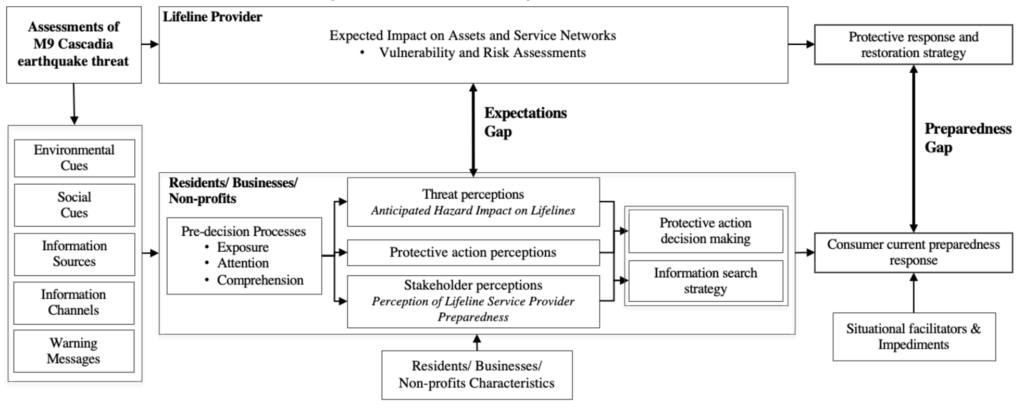Overview
While community lifeline service providers and local emergency managers must maintain coordinated response and recovery plans, their timelines may not match expectations of local consumers of lifeline services. Indeed, it is quite likely consumers have unrealistic expectations about lifeline restoration, which could explain current inadequate levels of disaster preparedness. This hypothesized expectation gap has received little attention because engineering research typically addresses providers’ capacities, whereas disaster research addresses household and business preparedness. Our project will address this neglected issue by assessing consumers’ (households, business owners/managers, nonprofit managers) expectations about lifeline system performance, and comparing them to lifeline provider capacity in a post-hazard event scenario (following a Cascadia subduction zone earthquake of 9.0 magnitude or greater) in two communities—Kirkland and Shoreline, WA. The research goal of this proposal is to identify and quantify determinants of the gap between societal expectations of critical lifeline systems performance in a hazard event and the planned resilience (avoiding failures/ timeline for service restoration) of these systems. The practical goal of this proposal is to enhance consumers’ preparedness and lifeline providers’ recovery capacity. We focus on energy, water, wastewater, and communication, whose restoration is critical for limiting cascading damages, and for rapid recovery of community functions.
Research Questions
- What do consumers think is the likely level of critical lifeline disruption from an earthquake and the timeline for restoration?
- What are consumers’ current levels of preparedness for lifeline interruption?
- What do lifeline providers and an independent engineering expert think are providers’ capabilities to maintain and restore lifeline services?
- How do consumers’ expectations compare with providers’ capabilities (expectations gap)?
- How will this study’s feedback about the expectations gap affect consumers’ and providers’ lifeline resilience expectations, as well as their mitigation and preparedness intentions?

Figure 1: Schematic Diagram Illustrating the relationships between research questions
RESEARCH Framework
Our research will extend the PADM by including consumer perceptions related to lifeline providers’ ability to restore operations and those related to threat from an event as moderators to assess the role of the identified expectations gap in influencing consumers’ preparedness and test the effect of providing consumers and providers with information about this gap.
We posit that low consumer preparedness for lifeline disruption is partly due to low expectations that lengthy disruption will occur. Among other reasons, this may be due to disbelief that the Cascadia event could happen within one’s planning horizon (duration of residence or business/nonprofit operation in the risk area), belief that the Cascadia event will have minimal impact on the community, and/or unrealistic optimism about providers’ ability to rapidly restore lifeline services. Our proposed sharing of professional estimates of lifeline restoration times should change these beliefs if our assumption about this specific basis for low preparedness is correct and if our audiences attend to, process, and act upon this information.

National Science Foundation (NSF) under Grant No. 2211077
PI: Himanshu Grover
